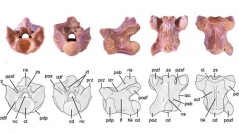

 Comptes Rendus Palevol
18 (7) - Pages 765-770
Comptes Rendus Palevol
18 (7) - Pages 765-770Two isolated trunk vertebrae from the ?uppermost Albian–lower Cenomanian Kem Kem beds of Morocco are described and assigned to Lapparentophis, an early snake genus known from coeval deposits in Algeria. The Moroccan specimens represent a new species, Lapparentophis ragei, which can be distinguished from the type and only known species, Lapparentophis defrennei, by its smaller size, its more elongate vertebrae, the presence of parazygosphenal foramina, and paradiapophyses extending anteroventrally closer to the cotyle. The discovery of Lapparentophis in the Kem Kem beds adds to the relatively diverse snake assemblage previously reported from this formation and extends the geographical range of the genus. The distribution of Lapparentophis and lapparentophiid-grade (?lapparentophiid) snakes is discussed. This poorly known family of terrestrial snakes seems to be restricted to the latest Albian–early Cenomanian of North Africa, with the exception of Pouitella from the early–middle Cenomanian of France. As for many other vertebrate taxa of this period, this distribution is consistent with a dispersal event from Africa to the western part of the European archipelago.
Squamata, Ophidia, Lapparentophiidae, Albian, Cenomanian, North Africa, palaeobiogeography